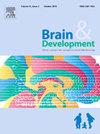先天性代谢错误的可治疗和可预防原因:印度儿童神经递质疾病队列
IF 1.3
4区 医学
Q4 CLINICAL NEUROLOGY
引用次数: 0
摘要
神经递质疾病是一组异质性疾病,包括合成、运输、受体结合和神经化学信使降解方面的缺陷。这些罕见的疾病范围从轻微的间歇性肌张力障碍到致命的脑病。自然病史和临床表现仍远未确定。研究时间为2015年10月至2024年9月。本研究旨在描述诊断为神经递质疾病的儿童的临床表现、实验室、影像学特征和遗传谱,并评估这些儿童的治疗方式和临床结果。结果29例患者中位年龄为12个月,男性居多。阳性家族史9例。最常见的表现是全面性发育迟缓(GDD)、肌张力障碍、癫痫发作伴自主神经障碍,且有日变化。神经递质障碍亚类为芳香L氨基酸脱羧酶缺乏症7例、酪氨酸羟化酶缺乏症3例、多巴胺转运蛋白缺乏症1例、水泡单胺转运蛋白2缺乏症(VMAT2) 2例、GTP环水解酶型缺乏症1例、6-吡啶-四氢蝶呤合酶缺乏症1例、二氢蝶呤还原酶缺乏症3例、七氢蝶呤还原酶缺乏症1例、甘氨酸脑病1例。folr1相关脑叶酸转运缺陷3例,琥珀酸半醛脱氢酶缺陷5例。所有病例的代谢检查均正常,其中5例儿童的串联质谱(TMS)显示苯丙氨酸水平升高。神经影像学异常7例,脑电图异常5例。多管齐下的早期治疗确保了这些儿童更好的预后。结论芳香l -氨基酸脱羧酶缺乏症是本系列中最常见的神经递质障碍类型,最常见的表现是全面发育迟缓和肌张力障碍。本文章由计算机程序翻译,如有差异,请以英文原文为准。
Treatable and preventable causes of inborn errors of metabolism: Cohort of neurotransmitter disorders in children from India
Background
Neurotransmitter disorders are a group of heterogeneous conditions that comprise defects in synthesis, transport, receptor binding, and degradation of neurochemical messengers. These rare disorders range from mild intermittent dystonia to lethal encephalopathies. The natural history and clinical presentation remain far from established.
Objectives
The study was conducted between October 2015 and September 2024. This study aims to describe the spectrum of clinical presentation, laboratory, imaging features, and genetic profiles of children diagnosed with neurotransmitter disorders and to assess the treatment modalities and clinical outcomes in these children.
Results
Among 29 patients, the median age was 12 months, with a male predominance. Positive family history was noted in 9 cases. The most frequent presentation was global developmental delay (GDD), dystonia, and seizures with autonomic disturbances, with diurnal variation. Various subcategories of neurotransmitter disorders are aromatic L amino acid decarboxylase deficiency-7 cases, tyrosine hydroxylase deficiency-3 cases, dopamine transporter deficiency syndrome-1 case, vesicular monoamine transporter 2 deficiency (VMAT2)-2 cases, GTP cyclohydrolase type deficiency-1 case, 6-pyruvoyl-tetrahydropterin synthase deficiency-1 case, dihydropteridine reductase deficiency-3, sepiapterin reductase deficiency-1 case, glycine encephalopathy-1 case, FOLR1-related cerebral folate transport deficiency-3 cases, and succinic semialdehyde dehydrogenase deficiency-5 cases. Metabolic workups were normal in all cases, with elevated phenylalanine levels in tandem mass spectrometry (TMS) in 5 children. Neuroimaging and electroencephalogram (EEG) were abnormal in 7 and 5 children, respectively. Multi-pronged and early treatment ensured better outcomes in these children.
Conclusion
The most common type of neurotransmitter disorder in our series was aromatic L-amino acid decarboxylase deficiency, with the most common presentation being global developmental delay and dystonia.
求助全文
通过发布文献求助,成功后即可免费获取论文全文。
去求助
来源期刊

Brain & Development
医学-临床神经学
CiteScore
3.60
自引率
0.00%
发文量
153
审稿时长
50 days
期刊介绍:
Brain and Development (ISSN 0387-7604) is the Official Journal of the Japanese Society of Child Neurology, and is aimed to promote clinical child neurology and developmental neuroscience.
The journal is devoted to publishing Review Articles, Full Length Original Papers, Case Reports and Letters to the Editor in the field of Child Neurology and related sciences. Proceedings of meetings, and professional announcements will be published at the Editor''s discretion. Letters concerning articles published in Brain and Development and other relevant issues are also welcome.
 求助内容:
求助内容: 应助结果提醒方式:
应助结果提醒方式:


